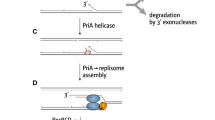Summary
We find that diaminopimelic acid in the recipient membrane is released into the medium during bacterial matings, indicating that membrane damage was inflicted on the recipient by the donor, probably for forming a channel for DNA transfer. When the damage is extensive, as in matings with an excess of Hfr bacteria, the F- bacteria are killed (lethal zygosis). The transfer of a large amount of DNA in Hfr matings appears to enhance the killing. In analogous F+xF- (Nalr) matings, on the other hand, killing of F- bacteria does not occur unless F plasmid transfer is inhibited by a substance like nalidixic acid. The F- bacteria are killed, suggesting that F plasmids contain genes that express immunity to lethal zygosis in the recipient. For example, bacteria containing surface exclusion-deficient mutants of F plasmids, such as traS - and traT -, induce lethal zygosis in F- bacteria and are susceptible to it. Various tra - polar mutants that abolish surface exclusion are also susceptible to lethal zygosis when mated with Hfr bacteria. Kinetic experiments indicate that in F+ (wild type) x F- matings, immunity to lethal zygosis is expressed in the F- recipient within 1/4 division time, whereas a complete expression of surface exclusion requires more than 1 division time. Thus, a complete change in all receptor sites seems to be required for the expression of surface exclusion.
Similar content being viewed by others
References
Achtman, M., Kennedy, N., Skurray, R.: Cell-cell interactions in conjugating Escherichia coli: role of traT protein in surface exclusion. Proc. Nat. Acad. Sci. USA 74, 5104–5108 (1977)
Achtman, M., Willetts, N., Clark, A.J.: Beginning a genetic analyis of conugational transfer determined by the F factor in Escherichia coli by isolation and characterization of transferdeficient mutants. J. Bacteriol. 106, 529–538 (1971)
Alfoldi, L., Jacob, F., Wollman, E.L.: Zygase létale dans les croisements entre souches colicinogènes et non colicogènes. C. R. Acad. Sci. 244, 2974–2976 (1957)
Anderson, T.F.: Recombination and segregation in Escherichia coli. Cold Spring Harbor Symp. Quant. Biol. 23, 47–58 (1958)
Bachmann, B.J., Low, K.B., Taylor, A.L.: Recalibrated linkage map of Escherichia coli K-12. Bacteriol. Rev. 40, 116–167 (1976)
Clowes, R.C.: Colicin factors and episomes. Genet. Res. 4, 162–165 (1963)
Davidson, N., Deonier, R.C., Hu, S., Ohtsubo, E.: Electron microscope heteroduplex studies of sequence relations among plasmids of Escherichia coli. X. Deoxyribonucleic acid sequence organization of F and F primes, and the sequences involved in Hfr formation. In: Microbiology (D. Schlesinger, ed.) Washington: American Society for Microbiology 1974
Fisher, K.W., Fisher, M.B.: Nalidixic acid inhibition of DNA transfer in Escherichia coli K-12. Cold Spring Harbor Symp. Quant. Biol. 33, 629–633 (1968)
Gross, J.D.: Cellular damage associated with multiple mating in E. coli. Genet. Res. 4, 463–469 (1963)
Hane, M.W., Hood, T.H.: Escherichia coli K-12 mutants resistant to nalidixic acid: Genetic mapping and dominance studies. J. Bacteriol. 99, 238–241 (1969)
Low, K.B., Wood, T.H.: A quick and efficient method for interruption of bacterial conjugation. Genet. Res. 6, 300–303 (1965)
Manning, P.A., Achtman, M.: Cell-to-cell interactions in conjugating Escherichia coli: the involvement of the cell envelope. In: Bacterial outer membranes (M. Inouye, ed.), pp. 409–447. New York: John Wiley & Sons 1979
Nagel de Zwaig, R., Anton, D.N., Puig, J.: The genetic control of colicinogenic factors E2, I and V. J. Gen. Microbiol. 29, 473–484 (1962)
Nagel de Zwaig, R., Puig, J.: The genetic behaviour of colicinogenic factor 3l. J. Gen. Microbiol. 36, 311–321 (1964)
Ou, J.T., Anderson, T.F.: Role of pili in bacterial conjugation: J. Bacteriol. 102, 648–654 (1970)
Ou, J.T., Anderson, T.F.: Effect of Zn2+ on bacterial conjugation: Inhibition of mating pair formation. J. Bacteriol. 111, 177–185 (1972)
Skurray, R.A., Reeves, P.: Characterization of lethal zygosis associated with conjugation in Escherichia coli K-12. J. Bacteriol. 113, 58–70 (1973a)
Skurray, R.A., Reeves, P.: Physiology of Escherichia coli K-12 during conjugation: Altered recipient cell functions associated with lethal zygosis. J. Bacteriol. 114, 11–17 (1973b)
Skurray, R.A., Reeves, P.: F factor-mediated immunity to lethal zygosis in Escherichia coli K-12. J. Bacteriol. 117, 100–106 (1974)
Skurray, R.A., Willetts, N., Reeves, P.: Effect of tra mutations of F factor-specific immunity to lethal zygosis. Mol. Gen. Genet. 146, 161–165 (1976)
Author information
Authors and Affiliations
Additional information
Communicated by T. Yura
Rights and permissions
About this article
Cite this article
Ou, J.T. Role of surface exclusion genes in lethal zygosis in Escherichia coli K12 mating. Molec. gen. Genet. 178, 573–581 (1980). https://doi.org/10.1007/BF00337863
Received:
Issue Date:
DOI: https://doi.org/10.1007/BF00337863




